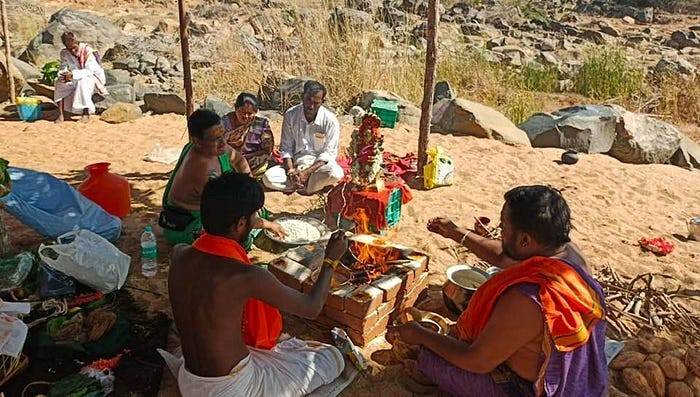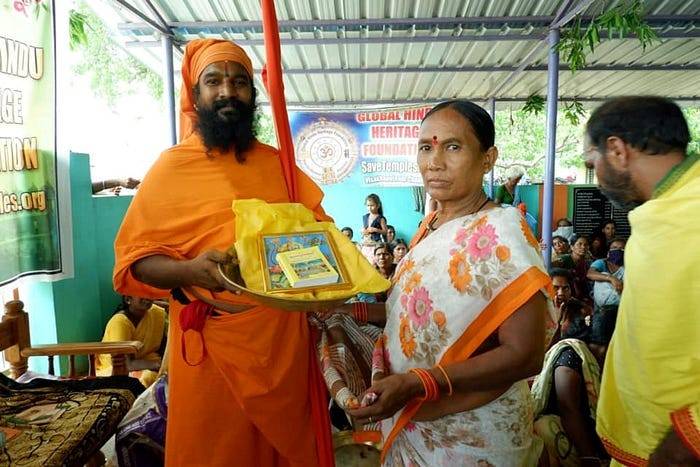[GHHF] An article on “Seven initiatives of the Global Hindu Heritage Foundation that will be remembered by generations to come” published in Medium magazine by S. Rajavardhan.
Mar 17, 2024
The world’s population stands at 7.88 billion, with the Hindu community comprising roughly 1.2 billion people, accounting for about 15% of the global population. However, estimating the Hindu population can be challenging and sometimes misleading due to its diverse beliefs, spiritual practices, and philosophical denominations, similar to the linguistic diversity seen across India. Often, the Hindu population is calculated by subtracting the numbers of Christians, Muslims, Parsis, and Jews from the total national population. Additionally, census methodologies default individuals into the Hindu religion unless stated otherwise.
Unlike the Abrahamic faiths, which share a common rejection of Hinduism due to historical forced conversions and contemporary deceitful tactics, the Hindu community is characterized by its intricate diversity, encompassing various languages, overlapping varnas, jatis, and sub-jatis. Adding complexity, newer jatis have been included in the list of scheduled castes and scheduled tribes by the Government of India, often influenced by political motives.
Post-independence, a plethora of atrocity literature has been fabricated with the aim of facilitating conversions to Christianity and Islam, taking advantage of social differences and historical chaos during invasions and colonialism. What was once visible as direct invasion in historical times has evolved into a psychological warfare targeting the Hindu community through various means, including calendar events and life cycle stages. Adversaries of Sanatan dharma are funded and supported by propagandist agendas, operating at multiple levels.
Only recently, with the advent of the internet, have the nefarious designs of propagandists been uncovered. The internet has enabled documentation, analytical prowess, and connectivity, revealing the threats faced by the Hindu community. Visionaries like Shri Rajiv Dixit began campaigning against this in the 1990s, while in the new millennium, community leaders like Dr. VV Prakash Rao have taken initiatives to unite the community through actionable efforts, notably through the Global Hindu Heritage Foundation. This article explores seven initiatives crucial for the present time, and with the GHHF leading these initiatives on the ground, their positive impact will be remembered for generations to come.
- UNIFYING A FRAGMENTED COMMUNITY UNDER THE FLAG OF DHARMA
“Sangha shakti kaliyuge” is a common saying in the RSS ideology. It reflects the idea that in the current era of Kali Yuga, where society is divided along linguistic, religious, and caste lines, unity in the form of a group or “sangha” is a source of strength and power. This unity is crucial to counter the challenges posed by modern-day adversaries, referred to as the modern-day Kauravas by the author Rajiv Dixit in the context of the ongoing battle for the preservation of Hindu society.
The Hindu community faces constant challenges, ranging from intellectual subversion to outright abuse. In such times, it becomes imperative to unite the broader Hindu community. While organizations like the RSS and other Hindu groups operate voluntarily across the country, the Global Hindu Heritage Foundation (GHHF) has taken proactive steps to unify the Hindu community in strategic regions where it is most needed.
The GHHF organized a membership drive in Assam, where 7,000 people gathered and pledged to stand united against Hinduphobic forces. Similar initiatives have been undertaken by the GHHF in other states like Telangana, Tamil Nadu, and West Bengal. These efforts aim to strengthen Hindu unity and resilience in the face of contemporary challenges.
- SECURING THE CONTINUITY OF DHARMA FOR GENERATIONS TO COME
Throughout global history, Sanatan Dharma has stood as the longest continuous civilization due to its unwavering commitment to Dharmic principles and the passing down of these values to future generations. Even in the face of adversity, our ancestors upheld Dharma steadfastly. However, in today’s attention-driven society, our lives are inundated with unwanted, meaningless, and unrighteous content, which has the potential to lead our future generations away from the path of Dharma as they embrace modern lifestyles and forget our traditional Dharmic values.
Recognizing this challenge, the Global Hindu Heritage Foundation has taken proactive steps to ensure the continuity of Dharmic values by establishing Bala Samskar Kendras across Telangana and Andhra Pradesh. These centers serve as platforms where children are educated about the importance of Dharma in both education and life. In these Bala Samskar Kendras, children learn about the rich history and valor of India and its warriors. They also participate in cultural activities such as singing, dancing, and bhajans, fostering a deep connection to their heritage.
These children represent the future of Bharat and serve as the torchbearers of the continuity of Sanatan Dharma into the future. Through these initiatives, the Global Hindu Heritage Foundation aims to instill Dharmic values in the younger generation and ensure that the legacy of Sanatan Dharma endures for generations to come.
- FIGHTING THE BATTLE FOR REAL INDEPENDENCE
During both World War 1 and 2, India served as a battleground for the British, with support from liberal “freedom fighters” of the time. Before leaving India, the British trained their Indian allies, known as brown sahibs, to maintain a favorable environment in independent India, protecting them from potential repercussions for their exploitation and seeking reparations. Special provisions were also made for missionaries to continue their religious conversion efforts unhindered. This included allocating vast amounts of land (17 crore acres) and legitimizing their proselytization activities. The southern states of Tamil Nadu, Andhra Pradesh, and Kerala, along with the northeastern states, saw widespread Christianization, tipping the balance of power in favor of other communities.
While churches had autonomy over their affairs, Hindu temples were subject to state control, including financial, managerial, and administrative aspects. Exploiting this, the church rewarded converts who advocated for their cause with administrative positions in temple management. Non-Hindu businessmen were also given access to temples to profit from devotees and pilgrims. This misuse of temple resources, particularly by the Tirumala Tirupati Devasthanams (TTD), prompted action from the Global Hindu Heritage Foundation (GHHF), which strongly opposed the practice and petitioned the highest state authorities, leading to corrective measures. Furthermore, temples are subjected to taxation on donations, while both central and state governments fund institutions of Christians and Muslims using money donated to temples by devotees. The state’s predatory actions continue, seeking to acquire more temples under the Endowments Act. The GHHF has been raising awareness through events and seminars advocating for the repeal of the Endowments Act. In one such event in 2015, Dr. Subramanian Swamy shared how he prevented the Tamil Nadu state government from taking over the Chidambaram temple by appealing to the Supreme Court.
- REVIVING TEMPLES
 The essence of Sanatan Dharma is intricately linked to our temples, which have endured the brunt of invasions throughout history. Many of these sacred sites suffered significant damage during periods of resistance and colonization. Even after independence, historical temples often faced neglect and apathy, with the Archaeological Survey of India prioritizing the maintenance of medieval invaders’ tombs over ancient Hindu temples. Recognizing the importance of temple revival, the Global Hindu Heritage Foundation (GHHF) stands out as one of the first institutions to prioritize this mission. Central to this effort is not only the restoration of temples but also the reinstatement of age-old customs and rituals that have been neglected for years. In one such endeavor, the foundation conducted the consecration ceremony (pran pratishtha) of an ancient Mariamman temple in a remote village in Andhra Pradesh.
The essence of Sanatan Dharma is intricately linked to our temples, which have endured the brunt of invasions throughout history. Many of these sacred sites suffered significant damage during periods of resistance and colonization. Even after independence, historical temples often faced neglect and apathy, with the Archaeological Survey of India prioritizing the maintenance of medieval invaders’ tombs over ancient Hindu temples. Recognizing the importance of temple revival, the Global Hindu Heritage Foundation (GHHF) stands out as one of the first institutions to prioritize this mission. Central to this effort is not only the restoration of temples but also the reinstatement of age-old customs and rituals that have been neglected for years. In one such endeavor, the foundation conducted the consecration ceremony (pran pratishtha) of an ancient Mariamman temple in a remote village in Andhra Pradesh.
In another initiative in a Karnataka village located 90 kilometers from Kalyandurgam, the GHHF facilitated the reinstallation of a 1300-year-old statue of the village deity, Goddess Yeti Gangamma, dating back to the Chola era. The foundation also revived the worship rituals of the deity, which had been dormant for a significant period.
Additionally, the GHHF has played a crucial role in supporting the Brahmin and priest community, which often lacks financial assistance from the government or endowment boards, unlike Christian pastors or Muslim clerics. In a rare initiative, the foundation has spearheaded fundraising efforts in the United States to sponsor priests for both new and revitalized temples, ensuring the continuation of traditional puja customs.
5. PUBLIC CELEBRATION OF HINDU FESTIVALS
In contemporary times, there’s a growing trend of public assertion of identity, notably among the Muslim and Christian communities, who often engage in assertive displays of their religious practices. This includes activities like roadside namaz and public iftar parties among Muslims, as well as candlelight vigils around churches on special occasions among Christians.
Reflecting on historical precedents, during the independence movement, Lokmanya Tilak initiated the Ganeshotsav as a public celebration of Hindu festivals to defy British oppression and unite people under one flag in the pursuit of freedom. Drawing inspiration from this, the Global Hindu Heritage Foundation has undertaken similar initiatives to promote the public celebration of Hindu festivals.
These efforts have yielded positive outcomes, with several villages in Vishakhapatnam joining in the public celebration of Dussehra, embracing the spirit of unity and festivity. More recently, another celebration was organized in the city for Mahashivratri, where devotees came together for a night-long vigil (jagran) to observe the auspicious occasion of Shiva’s great night.
 6. BRINGING BACK THE LOST ONES
6. BRINGING BACK THE LOST ONES
Swami Vivekananda once remarked that every Hindu who leaves Sanatan dharma through conversion becomes not only one Hindu less but also one enemy more. Despite the growing menace of conversion, efforts to bring back those who have left have been limited. While institutions like the Arya Samaj addressed this issue in the past, in recent times, only a few organizations, like Agniveer, have actively pursued the cause of ghar wapsi (homecoming).
Recognizing the importance of this initiative, the Global Hindu Heritage Foundation (GHHF) also took up the challenge and initiated ghar wapsi as part of its efforts. Through this initiative, converts were welcomed back into the Hindu fold, allowing them to resume their normal lives.
One event organized by GHHF saw remarkable success, with an estimated 100 people participating in ghar wapsi, and an even greater outcome of 123 people reverting to Sanatan dharma. While this initiative may seem like a drop in the ocean, in times of adversity, every drop of effort makes a significant difference.
7. CHALLENGING ADHARMA
The Global Hindu Heritage Foundation (GHHF) embarked on a powerful initiative to challenge adharma directly by addressing the issue of illegal places of worship belonging to other faiths in Bharat. Focusing primarily on Andhra Pradesh and Telangana, this initiative aims to seek the removal of illegal encroachments through legal and democratic means.
In November 2022, GHHF organized a fundraiser in Frisco, Texas, to gather funds for the removal of illegal structures around the Tirupati temple and the Tirumala hills in Andhra Pradesh. While the call for the removal of illegal structures is legitimate, some adversarial forces in the US and elsewhere launched a slander campaign to portray GHHF as a racist or supremacist organization, which it certainly is not. Nonetheless, the foundation is performing a valuable service to society by working towards removing structures that may pose a nuisance to the community at large.
In the broader context, GHHF is engaged in selfless service to the cause of dharma across various fronts, including the defense of dharma, preservation and revival of traditions, and standing up against adversarial forces. It is an institution worthy of support from all segments of society. Jai Shree Ram.

Rajvardhan is an AI professional with keen interest in culture, heritage and current affairs.












 Urgent support needed for Bangladesh Hindus
Urgent support needed for Bangladesh Hindus 







